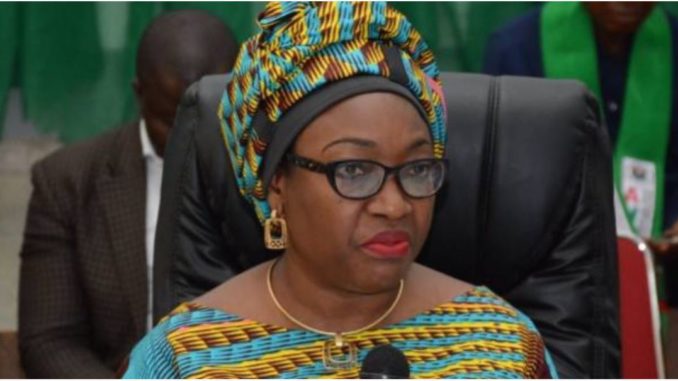
PRESIDENT Muhammadu Buhari recently highlighted the deep flaws in the civil service but, typically, came short of opting for sweeping change. Instead, he basked in the middling reforms of his administration such as payroll cleansing. He, like the Head of Service of the Federation, Winifred Oyo-Ita, however miss the point: Nigeria’s is a dysfunctional, corrupt and lumbering bureaucracy, requiring radical surgery, not tokenism, to enable it to fulfil its role of driving implementation of public policies.
Buhari acknowledged the hole into which the public service has sunk while inaugurating eight newly appointed federal permanent secretaries in Abuja. As usual, he laid the blame for the morass on past governments, including the destruction of checks and balances, corruption and abuse of power. Given the havoc the civil service has wrought in the past four decades and the cost of maintaining the bureaucracy, this is perhaps a gross understatement.
Described as the “thinking arm of sovereign nations,” the civil service is everywhere else the generator of ideas, the “mainspring of policy” that also drove Nigeria’s development in the pre- and immediate post-colonial eras. Today, by many accounts, the public service inhibits growth, is bloated and wracked by incompetence, nepotism, low morale, fraud and awe-inspiring corruption. As once admitted by the HoS, political appointees cannot raid the treasury without the connivance of these denizens of the bureaucracy.
Some are, in any case, very versatile thieves in their own right. Over 60,000 fictitious workers were identified by the Buhari administration after upgrading the Integrated Payroll and Personnel Information System introduced by its predecessor, thereby saving N142 billion in one year. Under the Goodluck Jonathan government, 50,000 “ghosts” had been similarly struck off the payroll after a biometric capture programme. The scam permeates the 36 states and 774 LGs: Delta State in 2015 uncovered 26,000 fake employees, while 18,000 others were found to have obtained employment with forged credentials. Bayelsa weeded 28,000 “ghosts,” Sokoto 12,915, Oyo 16,532 and Adamawa 12,609.
In December 2017, an FCT high court ordered temporary forfeiture of 86 vehicles, four houses and a quarry from a senior federal civil servant, assets that cannot be justified by his N500,000 monthly pay. One Yakubu Yesufu was arraigned for stealing N33 billion, while N197 billion pension funds recovered from pension thieves were allegedly re-looted.
Apart from their voracious greed, the federal, states and LG workers take the bulk of all revenues and annual budgets. Though a former finance minister, Kemi Adeosun, had in May 2018, bemoaned the government’s monthly N165 billion salary bill as unsustainable, returns filed with the Office of the Accountant-General of the Federation show that government spent N763.64 billion in the three months to March 2017. An audit found that despite IPPIS, N195.94 billion was overpaid to 450 Ministries, Departments and Agencies in 2016 in a recurring scam perpetrated by civil servants. This year, personnel costs are billed to reach N2.29 trillion from a total budget outlay of N8.83 trillion and representing 40 per cent of all projected revenue. From the centre to the states, the public service has become incurably inefficient, indolent and unimaginative.
As this newspaper has long argued, governments do not exist only to pay salaries or to maintain lumbering bureaucracies that cannot generate ideas, concretise or implement development policies. Buhari’s renewed mandate offers him an opportunity to initiate radical reforms to remake the civil service. Oyo-Ita’s stance against downsizing is disappointing. Even after expunging all the fictitious names from the payroll, the service has to be pruned as articulated by a former Central Bank of Nigeria Governor, Lamido Sanusi, who said that civil servants who constitute less than five per cent of the population, should not continue to draw over 70 per cent of government expenditure. Borrowing to pay salaries as the federal and most state governments are doing must give way to a rational public financing model.
To improve on the rank of 162 out of 193 countries on the 2017 World Bank Government Effectiveness Index, Nigeria should adopt global best practices. Apart from undertaking a drastic downsizing to flush out the dead wood, the corrupt and excess staff, a regime based on professionalism and merit should be introduced.
Meritocracy helped turn around poverty and underdevelopment in the “Asian Tigers,” according to researchers at the Education University of Hong Kong, “which benefited from an elite bureaucratic corps picked through highly competitive application processes and incentivised with handsome pay.” Singapore’s civil service, ranked No.1 on the World Bank index, applies a highly effective mix of competitive recruitment and pay, technology, training and incentives and a tough institutional anti-corruption regime to maintain a high standard of living for its citizens. In Africa, the Wilson Center, a US-based non-profit, noted initiatives by South Africa, Ghana and Ethiopia to adopt information technology tools to automate government processes, drastically cut red tape and reduce opportunities for graft. Rated as the continent’s leader in this regard, Kenya now deploys ICT in tax administration, e-Procurement for contracts and licensing and in digitisation of public records.
Yes; the Buhari government can lay claim to some reforms such as the Federal Civil Service Strategy and Implementation Plan 2017-2020, the Treasury Single Account and IPPIS, all geared towards a better service and stricter fiscal behaviour. However, more radical measures are needed; swift punishment and prosecution for “ghost” worker syndicates, dismissal of heads of the MDAs that harbour them and eviction of the lazy and the corrupt.
We have too many MDAs, with 541 identified in the Oronsaye report 2011: Buhari should implement recommendations of that panel drastically, introduce technology, merit and competitive entry and promotion exams and set goals and performance targets for agencies and personnel.
END

Be the first to comment